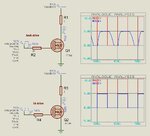hayowazzup
Advanced Member level 4
1. Could the microcontroller be blown up if a 5V signal from a signal generator is feeded to one of the MCU's output pin which is also outputting 5V?
2. When driving a MOSFET h-bridge on low side, is it necessary to have a resistor between the mosfets and the MCU's output pin?
2. When driving a MOSFET h-bridge on low side, is it necessary to have a resistor between the mosfets and the MCU's output pin?
Last edited:

